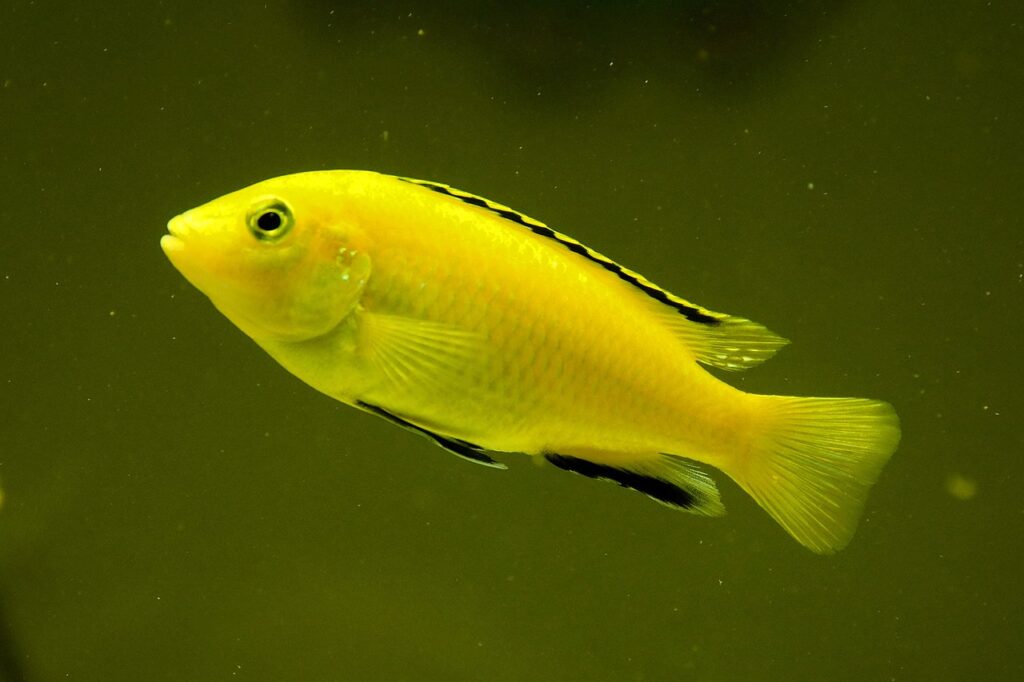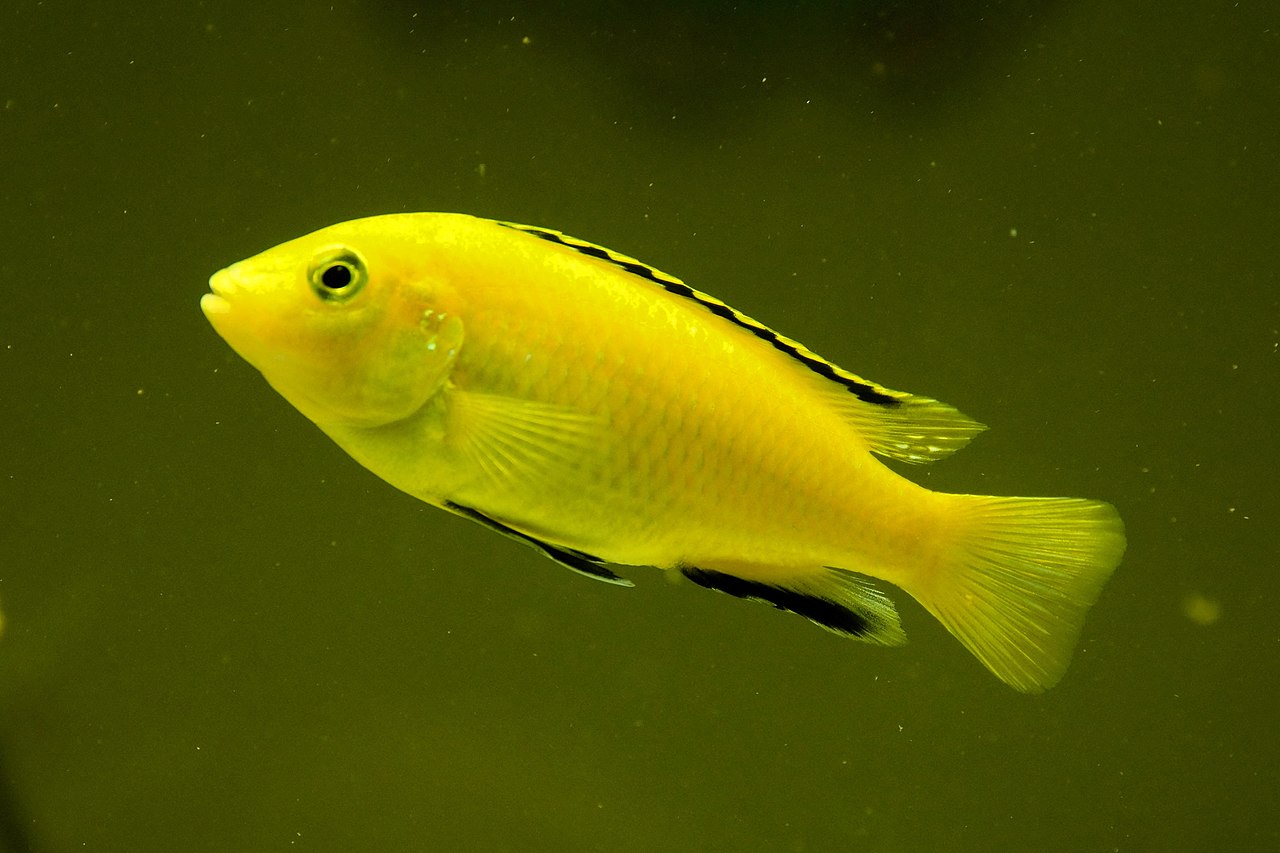Ah, the Electric Yellow Cichlid—also known by its scientific name, Labidochromis caeruleus. It’s a rock-dwelling beauty from Lake Malawi in Africa that’s taken the aquarium world by storm. Not only is this fish a visual delight, but it also boasts a fascinating history. First described in 1956, the Electric Yellow Cichlid rose to prominence in the late 20th century, becoming one of the most recognized African cichlids among aquarists.
Table of Contents
If you’re wondering about its family tree, the Electric Yellow Cichlid belongs to the Cichlidae family and shares its habitat with other African cichlids like the Mbuna and Peacock Cichlids. Its vibrant yellow hue is sometimes accompanied by secondary colors, like a white belly or even black markings along its fins and body. These unique colorations not only make it a showstopper in your tank but also serve as functional camouflage in its natural rocky habitat.
Speaking of its natural environment, this fish primarily dwells among the rocks but isn’t shy about exploring the middle levels of the water column. It thrives in water with a pH range of 7.8-8.6 and temperatures between 75-80°F (24-27°C). The Electric Yellow Cichlid is omnivorous, enjoying a balanced diet of algae, small crustaceans, insect larvae, and specialized cichlid pellets or flakes. While they’re social creatures, be prepared for a bit of territorial behavior, especially during breeding seasons. They tend to be semi-aggressive, so if you’re planning on having other fish in the tank, choose their tank mates wisely.
As for its popularity, the Electric Yellow Cichlid is anything but rare in the aquarium trade. However, selective breeding has led to different shades and patterns, adding to its allure. With an adult size of 4-5 inches and a lifespan that can stretch up to a decade, these fish are a long-term commitment but well worth it. A minimum of a 30-gallon tank is recommended for keeping a small group of these cichlids.
You might be intrigued to learn some fun facts about our Electric Yellow Cichlid friend. For instance, these fish are mouthbrooders—the female carries the fertilized eggs in her mouth until they hatch. Also, despite their territorial tendencies, these cichlids are known to form small communities where males can co-exist in relative peace.
Whether you’re a novice aquarist or a seasoned pro, the Electric Yellow Cichlid makes for an eye-catching and engaging addition to your aquatic family. Its hardiness, colorful appeal, and interesting behaviors promise to make fishkeeping a rewarding experience.

Key Information
The Electric Yellow Cichlid is admired not only for its radiant yellow hue but also for its subtle variations. While the fish is predominantly yellow, selective breeding has led to the emergence of different shades and patterns that captivate the eyes of aquarists. From those with white bellies to others displaying black markings, the Electric Yellow Cichlid offers a delightful range of options for enthusiasts seeking to add a splash of color to their aquariums.
| Family | Cichlidae |
| Price | Generally ranges from $6 to $20 depending on size and variant |
| Common Names | Electric Yellow Cichlid, Yellow Lab Cichlid, Lemon Yellow Lab |
| Variants | Predominantly yellow; some have white bellies or black markings |
| Ideal Tank Size | Minimum 30 gallons for a small group |
| Water Parameters | pH 7.8-8.6, Temperature 75-80°F (24-27°C) |
| Lifespan | Up to 10 years under optimal conditions |
| Full Size | 4-5 inches (10-12.5 cm) |
| Natural Environment | Lake Malawi, Africa |
| Behavior | Social but can be territorial, especially during breeding |
| Habitat Preference | Rocky areas, occasionally ventures to mid-water levels |
| Aquarium Decoration | Rocks, caves, and driftwood for hiding and territorial claims |
| Ideal Tank Mates | Other African cichlids, catfish, and non-aggressive species |
| Fish to Avoid | Aggressive or overly territorial species |
| Best Foods/Diet | Algae, small crustaceans, insect larvae, cichlid pellets/flakes |
| Disease | Susceptible to common freshwater diseases like Ich |
| Sex-Switch | No known sex-switching behavior |
| Gender Differences | Males often brighter; females may have subdued colors |
| Care Level | Moderate; suitable for beginners to advanced aquarists |
| Breeding Level | Moderate; mouthbrooders |
Ideal Tank Mates
When it comes to finding the perfect tank mates for the Electric Yellow Cichlid, compatibility is key. Given its semi-aggressive temperament, especially during breeding seasons, it’s essential to choose tank mates that can coexist peacefully with this vibrant cichlid. The general rule of thumb is to opt for fish that share similar water parameters and habitat preferences but aren’t so similar that they’ll be seen as territorial threats. Additionally, the ideal tank mates should be neither too aggressive nor too timid to ensure a balanced and stress-free environment for all the aquarium inhabitants. Here are 15 ideal tank mates, each explained in detail:
Acei Cichlid
The Acei Cichlid is a good choice because it’s another member of the African cichlid family and is accustomed to the same water conditions. Its peaceful nature makes it less likely to engage in territorial disputes with the Electric Yellow Cichlid.
Red Zebra Cichlid
This fish is another African cichlid that’s well-suited to share a tank with the Electric Yellow Cichlid. Their similar size and water requirements make them compatible, although it’s important to provide enough hiding spots to minimize territorial disputes.
Bristlenose Pleco
This bottom-dweller is an excellent tank mate as it mostly keeps to itself and helps keep the tank clean. Its peaceful temperament makes it unlikely to clash with the Electric Yellow Cichlid.
African Butterfly Cichlid
Known for its calm demeanor, the African Butterfly Cichlid can comfortably share a tank with the Electric Yellow Cichlid. Both fish are native to similar water conditions, making them a good match.
Yellowtail Acei
This is another peaceful African cichlid species. Its diet and environmental needs closely match those of the Electric Yellow Cichlid, making it an excellent tank mate.
Cobalt Blue Zebra Cichlid
This African cichlid species is known for its striking blue color and shares similar water and dietary requirements with the Electric Yellow Cichlid. Their colors can complement each other beautifully in a tank.
Cherry Barb
Though not an African cichlid, the Cherry Barb is peaceful and fast enough to avoid conflicts. It can add a different color palette to the aquarium, making it visually appealing.
Synodontis Catfish
This bottom-dwelling fish is native to African waters and is generally peaceful. It’s compatible with the Electric Yellow Cichlid due to similar environmental and dietary needs.
Clown Loach
Though they prefer slightly different water parameters, Clown Loaches are often successfully kept with African cichlids. They are peaceful and spend most of their time at the bottom of the tank.
Rainbowfish
Rainbowfish are known for their vibrant colors and peaceful nature. They usually swim in the middle to upper parts of the water column, avoiding any potential territorial disputes with the Electric Yellow Cichlid.
Peacock Cichlid
Another stunning African cichlid, the Peacock Cichlid is known for its bright colors and similar habitat requirements, making it a compatible tank mate for the Electric Yellow Cichlid.
Johanni Cichlid
The Johanni Cichlid is another African cichlid that can coexist peacefully with the Electric Yellow Cichlid, given adequate space and hiding spots in the tank.
Leopard Bush Fish
Though not a cichlid, the Leopard Bush Fish can adjust to similar water parameters and is generally peaceful, making it a suitable tank mate.
Rosy Barb
The Rosy Barb is a hardy fish that can adapt to a variety of water conditions. Its peaceful temperament and speed make it a good match for the Electric Yellow Cichlid.
White Cloud Mountain Minnow
This is a peaceful, schooling fish that tends to swim in the upper parts of the tank, thereby avoiding the Electric Yellow Cichlid’s territory. Its hardiness and adaptability make it a suitable tank mate.
By carefully selecting tank mates that are compatible in terms of temperament, environmental needs, and dietary requirements, you can create a harmonious and visually captivating aquarium that includes the Electric Yellow Cichlid.
FAQs
Can Electric Yellow Cichlids Live in a Community Tank?
Yes, Electric Yellow Cichlids can be part of a community tank, provided that the other inhabitants are compatible in temperament and environmental needs. However, mixing them with fish from different regions, like South American cichlids, is generally not recommended due to differing water parameters and potential aggression issues.
How Do I Differentiate Between a Male and Female Electric Yellow Cichlid?
Male Electric Yellow Cichlids are often brighter and may display more vivid coloration, especially during breeding seasons. Females are generally smaller and may have more subdued colors. However, it can still be challenging to differentiate between the two genders, especially in younger fish.
Do Electric Yellow Cichlids Change Color?
Yes, Electric Yellow Cichlids can change color based on various factors like stress, illness, or environmental changes. A sudden color change is usually a sign that something is off, and you should check the water parameters and overall health of the fish.
What Are Some Signs of Stress in Electric Yellow Cichlids?
Signs of stress include rapid gill movement, erratic swimming, loss of color, or hiding for extended periods. Stress can be due to various factors like poor water quality, incompatible tank mates, or sudden changes in the environment.
Can Electric Yellow Cichlids Be Kept With Live Plants?
While it’s possible to keep Electric Yellow Cichlids with live plants, it’s essential to choose hardy plant species that can withstand their digging behavior. Plants like Java Fern or Anubias are good options as they can be attached to rocks, making it difficult for the cichlids to uproot them.
How Do Electric Yellow Cichlids React to Light?
Electric Yellow Cichlids are generally tolerant of different lighting conditions. However, providing a natural day-night light cycle is beneficial for their well-being. Excessive bright light can cause stress, so it’s recommended to have some shaded areas in the tank.
Is it Normal for Electric Yellow Cichlids to Dig?
Yes, digging is a natural behavior for Electric Yellow Cichlids. They often dig to create territories or spawning sites. It’s advisable to secure any tank decorations to prevent them from being toppled over.

Leave a Reply